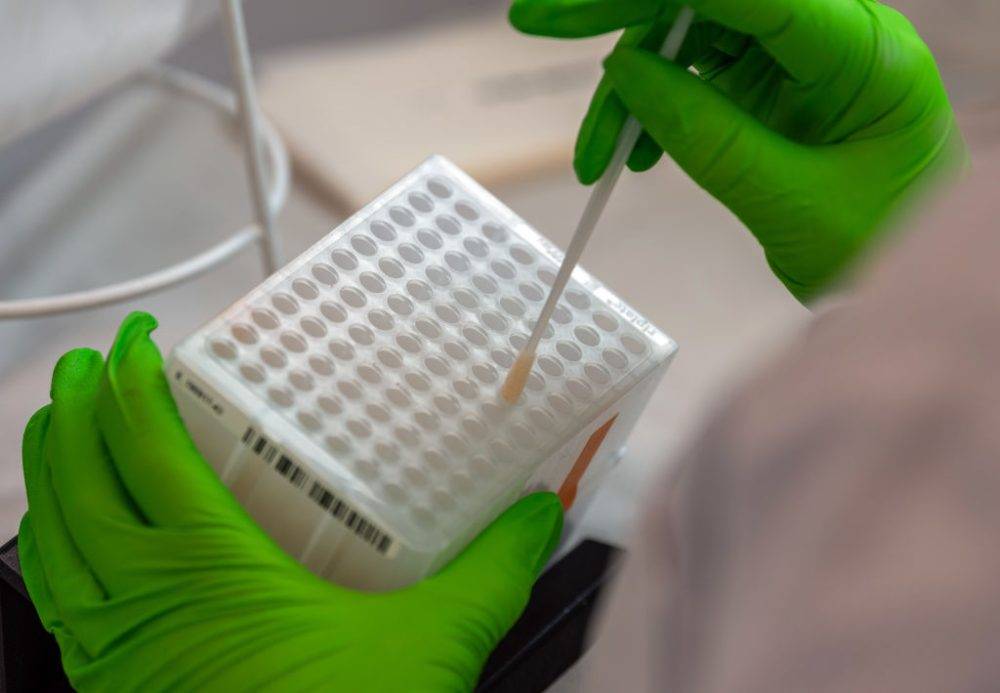
18 September 2019, Saxony, Dresden: An employee in the DKMS Life Science Lab, in the former building of the Dresdner Bundesbank, is working on the sorting of medical cotton swabs with cells of the buccal mucosa for the typing process of DNA. Each day can be registered in Germany over 1900 humans again as stem cell donors with the DKMS, world-wide there are over 3400. Each individual of you is analyzed in the DKMS stem cell donor laboratory for its tissue characteristics, the so-called HLA-Typisierung. Photo: Robert Michael/dpa-Zentralbild/dpa (Photo by Robert Michael/picture alliance via Getty Images)
Seventeen-year-old Anele, who was diagnosed with acute lymphoblastic leukaemia, a type of cancer that affects the production of healthy blood cells, is one of many people in need of a stem cell transplant from a matching donor. With his son hanging on for dear life, Lawrence is waiting for that one person to be a match.
Although thousands of South Africans have registered as potential bone marrow stem cell donors, there is a critical problem — donor attrition. These dropout rates, ranging from 23% to 56%, can significantly delay finding a suitable match for blood cancer patients in desperate need of a potentially life-saving transplant. This can affect their chances of survival. Every registered donor brings hope to a patient battling blood cancer.
Although donating stem cells is a safe and relatively simple process, various misconceptions deter registered donors from following through with donations, which is important during Bone Marrow Stem Cell Donation and Leukaemia Awareness Month that runs from 15 August to 15 October.
Myth 1: Donating stem cells is a painful surgical procedure.
Fact: For more than 90% of donors the process entails peripheral blood stem cell (PBSC) collection, a non-surgical procedure similar to donating blood. During PBSC, donors will rest comfortably while a needle is placed in each arm. Blood is drawn from one arm, passed through a machine that separates the stem cells, and the remaining blood is returned to the body through the other arm. Although not painful, some donors may experience mild side effects such as headaches, fatigue or muscle aches, which typically resolve quickly.
For a small percentage of donors (about 2%), stem cells can be collected directly from the bone marrow in the pelvic bone. This minimally invasive procedure is performed under general anaesthesia. Although some donors experience temporary discomfort or soreness at the extraction site, the feeling is usually comparable to a bruise.
Myth 2: Donating takes too long.
Fact: While the donation process involves some steps, it’s designed to be manageable. You’ll have a briefing call to explain the process, a health check to confirm your suitability and an informative session about donation itself. The actual donation typically takes less than a day (four to six hours) for the PBSC method.
For the bone marrow donation method, a hospital stay is involved, but it’s usually just three days. This includes check-in on day one, the procedure on day two and discharge on day three.
Myth 3: Donating stem cells means missing a lot of work.
Fact: The good news is that most donors can get back to work quickly. For PBSC donation, donors will be able to return within two days. If they donate bone marrow, a bit more recovery time is needed, so they should plan for about one week of leave.
Myth 4: My boss won’t be okay with me taking time off to donate.
Many employers are incredibly supportive of staff who donate stem cells. In our experience, most react positively to this selfless act. If your company doesn’t offer paid leave for donation, the nonprofit DKMS Africa has a financial assistance programme that deals with lost wage compensation.
Myth 5: Donating stem cells will cost me money.
Fact: A donation is free. DKMS covers all donation-related expenses, including travel, meals and accommodation if needed. Financial support is also provided for a companion to join them at the hospital. The donor’s health insurance will never be involved, and DKMS handles the costs of any follow-up care that might be necessary.
Palesa Mokomele is the head of community engagement and communications at DKMS Africa.Register today at https://www.dkms-africa.org/register-now. For more information, contact DKMS Africa on 0800 12 10 82.



 1 month ago
73
1 month ago
73













